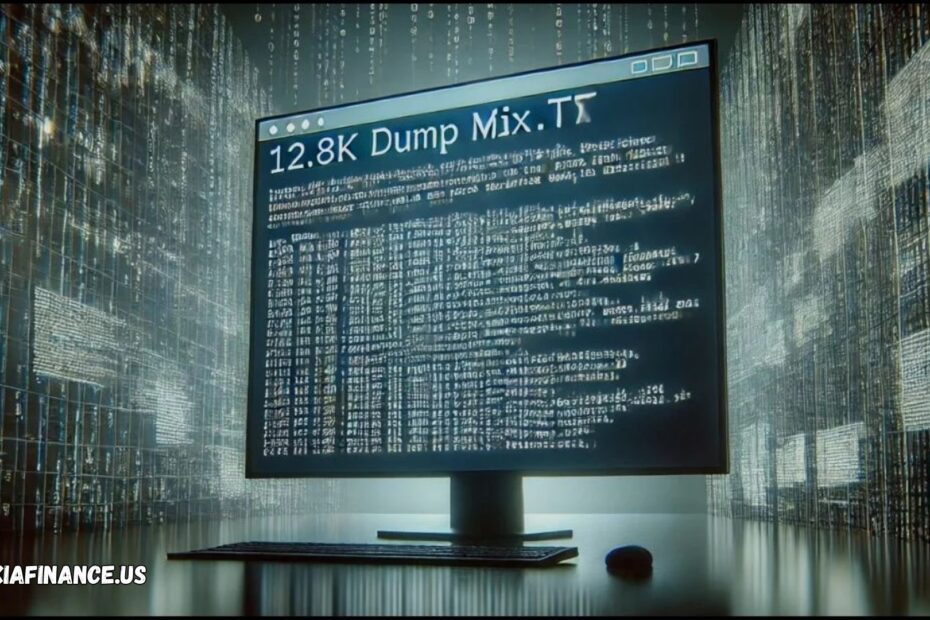Discover the significance of the “12.8kk dump mix.txt” file. Learn what it means, risks, best practices, and steps to safeguard your data
Table of Contents
Understanding “12.8kk Dump Mix.txt”: An In-Depth Guide to Data Security
The term “12.8kk dump mix.txt” has been appearing more frequently in cybersecurity discussions, sparking concern and curiosity alike. If you’ve seen this term online or heard about it in security briefings, you’re likely wondering what it is and why it matters. This article aims to demystify the term “12.8kk dump mix.txt,” explore what it means, and shed light on the larger issue of data breaches it represents. As data security grows more complex, it’s essential to know how to protect yourself from cyber threats. Read on to understand the implications of this file format and learn best practices to keep your data secure.
Introduction to “12.8kk Dump Mix.txt”
The “12.8kk dump mix.txt” is essentially a file format that typically contains sensitive data obtained through illicit means, often posted for sale or shared on unauthorized forums. With over 12.8 million entries, this type of file can include personal details, credit card information, email addresses, and other confidential data.
This guide is crafted to clarify what “12.8kk dump mix.txt” files are, where they come from, and how individuals and organizations can mitigate the associated risks. As cyber threats continue to grow, knowing how to safeguard your information is vital.
Read on to discover best practices and gain essential insights into protecting your digital footprint.
What is a Data Dump?]

Data dumps are large sets of information, often compiled from data breaches or unauthorized sources. They’re frequently packaged into files and circulated on the dark web or hacker forums. The “12.8kk dump mix.txt” falls under this category, with a staggering number of entries leaked from various sources.
Types of Data Commonly Found in Dumps
- Personal Identifiable Information (PII): Names, addresses, birthdates, etc.
- Financial Information: Credit card numbers, bank details.
- Email and Password Combinations: Common in account hacking.
- Social Security Numbers and Other Sensitive IDs: Used for identity theft.
Data dumps pose a severe risk because they are usually made available at a low cost, or even free, allowing malicious actors easy access to sensitive data.
Risks Associated with “12.8kk Dump Mix.txt” Files
The risks tied to files like “12.8kk dump mix.txt” are broad and can impact individuals and organizations alike.
For Individuals
- Identity Theft: Cybercriminals can exploit personal information for fraudulent activities.
- Financial Loss: Unauthorized access to financial data can lead to draining bank accounts or credit card fraud.
- Loss of Privacy: Even non-financial information can be used for phishing attacks.
For Organizations
- Reputational Damage: Breaches can erode customer trust.
- Financial Consequences: Legal fees, fines, and the cost of implementing new security measures.
- Operational Disruption: Managing the fallout of a data breach can consume significant resources.
Understanding these risks is the first step to taking proactive measures for protection.
How “12.8kk Dump Mix.txt” Spreads Online

1. Dark Web Forums
These files are typically shared on hidden forums accessible through the dark web. The anonymity of the dark web allows cybercriminals to operate largely untraceable.
2. Peer-to-Peer Sharing
Certain files are circulated using file-sharing protocols that bypass mainstream internet controls.
3. Hacker Groups and Leaks
Hacker collectives might post them as proof of their hacking achievements or to threaten a targeted organization.
Knowing these channels can help in identifying red flags and taking preventive steps.
Key Facts and Stats on Data Breaches
- Frequency of Breaches: According to cybersecurity reports, an attack occurs approximately every 39 seconds.
- Average Cost of Data Breach: Around $4.35 million globally.
- Compromised Accounts: More than 80% of data breaches are caused by weak or reused passwords.
These stats emphasize the importance of safeguarding personal and organizational data.
Best Practices for Data Security
Securing your data requires a multi-layered approach that covers both technology and behavior.
1. Use Strong, Unique Passwords
- Avoid using the same password across multiple platforms.
- Implement two-factor authentication (2FA) for additional security.
2. Regularly Update Software
- Ensure all devices and software are up-to-date to guard against vulnerabilities.
3. Limit Personal Information Sharing
- Refrain from sharing sensitive details on social media or unsecured websites.
4. Back-Up Data
- Regularly back up essential data to an offline source.
Following these practices can reduce vulnerability to breaches.

Common Mistakes in Data Protection
- Weak Password Practices: Relying on easily guessable or repeated passwords.
- Ignoring Security Updates: Outdated software is more prone to attacks.
- Sharing Too Much Information Online: Even seemingly harmless posts can provide data for hackers.
- Clicking on Suspicious Links: Phishing attacks remain a common entry point for breaches.
Avoid these errors to ensure your data remains secure.
Future Trends in Cybersecurity
- Increased Adoption of Artificial Intelligence (AI): AI is being used to detect patterns that indicate potential threats.
- Biometric Security Measures: Fingerprint and facial recognition add an extra layer of security.
- Enhanced Encryption Methods: Data encryption is becoming more sophisticated, making it harder for hackers to access sensitive information.
- Zero-Trust Architecture: A model that assumes no trust within or outside the network, enforcing strict access controls.
These trends highlight a proactive shift in protecting against evolving cyber threats.
Conclusion
Understanding files like “12.8kk dump mix.txt” is crucial in today’s digital landscape, where data breaches are alarmingly common. Protecting your information requires awareness, proactive measures, and a commitment to security best practices. From using strong passwords to keeping software up-to-date, these steps help minimize your risk of falling victim to data breaches.
Start implementing these practices today to secure your digital footprint and avoid the pitfalls of data vulnerabilities.
FAQ
Q1: What does “12.8kk” in the file name mean?
A: “12.8kk” indicates that the file contains approximately 12.8 million entries.
Q2: Where are these files typically found?
A: They’re usually shared on the dark web or in hacker forums.
Q3: What should I do if my data is in a dump file?
A: Change passwords immediately, enable 2FA, and monitor accounts for suspicious activity.
Q4: Are all data dumps illegal?
A: Data dumps from breaches are unauthorized and illegal. However, some companies release anonymized data dumps for research purposes legally.
Q5: How can I verify if my data is compromised?
A: Use data breach notification services, like Have I Been Pwned, to check for compromised accounts.
Internal and External Links
For a comprehensive approach to data security, check our guide to password protection and explore our resources on two-factor authentication.
